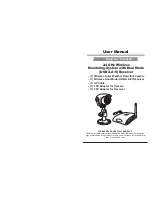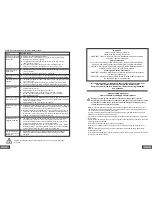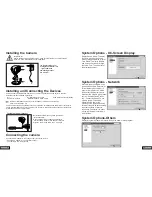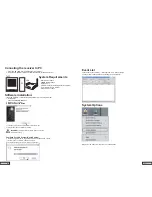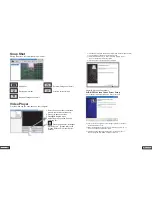
4.
21.
Error
Possible cause
No image and
no sound
Camera or receiver are not supplied with electricity.
Is the power pack plugged in correctly?
The distance between the camera and receiver is too long.
The image/sound is.
distorted
The range of the system was exceeded. Shorten the distance.
There is a strong interference source (e.g. electric engine, walkie-talkie,
etc.) nearby.
Flickering/running
image
Strong spotlight in the cover range of the camera.
Normal sound,
image is too light
or dark.
Surveillance monitor (TV) is adjusted wrongly (readjust brightness).
Strong spotlight in the cover range of the camera.
White image only
on the monitor.
The supply voltage is too low (change batteries or power
pack operation)
Observe the safety notices under all circumstances!
When I connect the receiver to my TV, I found...
Continue on the next page...
Disposal
If the camera system no longer functions or can no longer be repaired, it must be disposed of
according to the valid statutory regulations.
Disposal of spent batteries / accumulators
You are required by law (Battery Ordinance) to return all spent batteries and accumulators.
Disposing of spent batteries/accumulators with common household waste is prohibited! Batteries /
accumulators that contain hazardous substances are marked with the symbols on the side. These
symbols indicate that it is prohibited to dispose of these batteries/ accumulators in the household
waste. The abbreviations for the respective heavy metal are: Cd= cadmium, Hg= mercury, Pb= lead.
You can return spent batteries and accumulators that can no longer be charged to the designated
collection points in your community, our outlets or wherever batteries or accumulators are sold.
Following these instructions allow you to fulfill the legal requirements and contribute to the protection
of our environment!
Troubleshooting
This camera system reflects the latest state of technology and is safe to operate. In case of problems
or malfunctions follow these troubleshooting steps.
This equipment generates and uses radio frequency energy and if not installed and used properly,
that is, in strict accordance with the manufacture's instructions, may cause interference to radio and
television reception. It has been tested and found to comply with limits for a Class B digital device in
accordance with Part 15 of FCC Rules and CE I-ETS 300 440, which are designed to provide
reasonable protection against such interference in a residential installation. However, there is no
guarantee that interference will not occur in a particular installation. If this equipment does cause
interference to radio or television reception, which can be determined by turning the equipment off
and on, the user is encouraged to try to correct the interference by one or more of the following
measures:
1. Reorient the TV/radio antenna.
2. Relocate the Receiver away from the TV/radio receiver.
3. Plug the Receiver into a different wall outlet so that the Receiver is on a different branch circuit.
4. If necessary, the user should consult the dealer or an experienced radio/television technician
for additional suggestions.
The user may find the following booklet prepared by the Federal Communication Commission helpful:
"How to Identify and Resolve TV Interference Problems." This booklet is available from the US
Government Printing Office, Washington, D.C. 20402, Stock No. 004-000-00345-4.
FCC/CE NOTICE
The user is cautioned that changes or modifications not expressly approved by the manufacturer
could void the user's authority to operate the equipment. Linear radio controls provide a reliable
communications link and fill an important need in portable wireless signaling. However, there are
some limitations which must be observed. The radios are required to comply with FCC Rules and
Regulations as Part 15 devices and CE I-ETS 300 440. As such, they have limited transmitter
power and therefore limited range. A receiver cannot respond to more than one transmitted signal
at a time and may be blocked by radio signals that occur on or near their operating frequencies.
Changes or modifications to the device may void FCC and CE compliance. Infrequently used radio
links should be tested regularly to protect against undetected interference or fault.
FCC/CE WARNING

